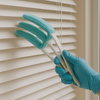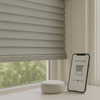Top 5 Mistakes to Avoid When Installing Roller Blind Fittings
- by Giorgi Gogidze

Installing roller blinds can transform any room by providing privacy, light control, and enhanced aesthetics. However, the difference between a professional-looking installation and a disappointing result often comes down to avoiding common mistakes that even experienced DIY enthusiasts can make. Whether you're installing a sophisticated blackout roller blind in your bedroom or a stylish window treatment in your living room, understanding these critical errors can save you time, money, and frustration.
[toc]
The installation process for roller blind fittings might appear straightforward, but the details matter enormously. Small mistakes in measuring, positioning, or securing can lead to blinds that don't operate smoothly, look uneven, or fail prematurely. These issues become particularly problematic with heavier treatments like black out roller blinds, where proper support and alignment are crucial for long-term functionality.
Professional installers develop their expertise by learning from countless installations and understanding how different window types, wall materials, and blind specifications interact. By recognizing and avoiding the most common mistakes, you can achieve professional-quality results while building confidence in your DIY abilities. The key lies in understanding not just what to do, but specifically what not to do during the installation process.
This comprehensive guide examines the five most critical mistakes that can compromise your roller blind installation, providing detailed explanations of why these errors occur and practical strategies for avoiding them. Armed with this knowledge, you'll be better prepared to achieve the smooth, professional-looking results that make roller blinds such an attractive window treatment option.
Mistake #1: Incorrect Measurement and Planning
The foundation of any successful roller blind installation lies in accurate measurements and thorough planning. This crucial first step determines everything from the blind's fit and appearance to its operational effectiveness. Unfortunately, measuring errors represent the most common and costly mistake in roller blind installations, often requiring complete reinstallation or blind replacement.
The complexity of measuring for roller blind fittings extends beyond simply recording window width and height. You must consider the mounting method (inside mount versus outside mount), the space required for roller blind brackets, and the clearance needed for smooth operation. Inside mount installations require precise measurements to ensure the blind fits within the window frame without binding, while outside mount installations need careful consideration of overlap requirements for optimal light control.
Many installers make the mistake of measuring only once or failing to account for window frame irregularities. Professional installers always measure width at the top, middle, and bottom of the window opening, using the smallest measurement to ensure proper fit. Height measurements should similarly be taken at multiple points, particularly important for older homes where settling may have created non-square openings.
The type of blind being installed significantly impacts measurement requirements. A blackout roller blind typically requires more precise measurements and greater overlap than standard blinds due to their light-blocking function. The fabric weight and thickness also affect how much clearance is needed for smooth operation, particularly important when calculating inside mount depths.
Planning extends beyond measurements to include consideration of obstacles like window handles, locks, or protruding trim that might interfere with blind operation. These factors must be identified and addressed during the planning phase rather than discovered during installation when modifications become more difficult and expensive.
Mistake #2: Improper Roller Blind Brackets Positioning
Roller blind brackets serve as the foundation for your entire window treatment system, making their proper positioning absolutely critical for successful installation. Incorrect bracket placement represents one of the most frustrating mistakes because it often becomes apparent only after the blind is installed and fails to operate correctly. This error typically requires removing and repositioning brackets, potentially damaging walls and requiring additional repair work.
The most common bracket positioning error involves incorrect spacing or alignment. Roller blind brackets must be positioned to support the blind's weight evenly while ensuring the roller tube remains perfectly level. Even slight misalignment can cause the blind to drift to one side during operation, creating uneven hanging and potential operational problems. This issue becomes particularly problematic with heavier treatments like black out roller blinds, where uneven weight distribution can stress mounting hardware and cause premature failure.
Height positioning of roller blind brackets requires careful consideration of both aesthetic and functional factors. Brackets positioned too high create excessive gaps above the blind, compromising privacy and light control. Conversely, brackets placed too low may interfere with window operation or create insufficient clearance for the blind to roll up completely. The optimal position balances these considerations while ensuring adequate support for the blind's weight and operation.
The distance between brackets is another critical factor often overlooked by inexperienced installers. Insufficient support spacing can cause the roller tube to sag in the middle, particularly problematic with wider blinds or heavier fabrics. Most manufacturers provide specific guidelines for maximum bracket spacing based on blind width and weight, but these recommendations are frequently ignored or misunderstood.
Wall anchoring represents another crucial aspect of bracket positioning. The wall material and condition must be assessed to determine appropriate anchoring methods. Hollow walls require toggle bolts or wall anchors rated for the blind's weight, while solid walls may accommodate standard screws. Failing to match anchoring hardware to wall conditions can result in bracket failure and potential damage to both the blind and surrounding wall area.
Mistake #3: Inadequate Wall Anchoring and Support
The structural integrity of your roller blind installation depends entirely on adequate wall anchoring and support systems. This critical aspect is frequently underestimated, leading to installations that may appear successful initially but fail over time as daily use stresses inadequately secured mounting points. The consequences of poor anchoring range from minor operational issues to complete installation failure and potential property damage.
Understanding wall construction is essential for selecting appropriate anchoring methods. Different wall types – drywall, plaster, brick, or concrete – require specific anchoring approaches and hardware. Many installers make the mistake of using standard screws in all situations, failing to recognize that hollow walls need specialized anchors to distribute weight loads effectively. This oversight becomes particularly problematic with heavier treatments like blackout roller blinds, where the fabric weight combined with operational forces can exceed the holding power of inadequate anchors.
The weight rating of anchoring hardware must match or exceed the total weight of the roller blind kit plus any operational forces. Many installers underestimate these forces, focusing only on the static weight of the blind rather than considering the dynamic loads created during operation. Pulling forces from corded operation, wind loads on outdoor installations, and the cumulative stress of repeated use all contribute to the total load that anchoring systems must support.
Anchor placement within wall studs provides the most secure mounting option for heavy blinds, but stud locations don't always align with optimal bracket positions. Professional installers often use blocking or mounting boards to bridge between studs, distributing loads across multiple attachment points. This approach is particularly important for wide blinds or installations where aesthetic requirements prevent direct stud mounting.
The quality of wall anchors varies significantly, and selecting appropriate hardware requires understanding both the immediate and long-term load requirements. Cheap plastic anchors may initially support lightweight blinds but can fail gradually, allowing brackets to work loose over time. Quality metal anchors with appropriate weight ratings provide more reliable long-term support, particularly important for frequently operated blinds.
Mistake #4: Ignoring the Specific Requirements of Blackout Roller Blinds
Black out roller blinds present unique installation challenges that are often underestimated by installers familiar with standard blind installations. The specialized nature of blackout fabrics and their intended function requires modified installation approaches that account for light-blocking effectiveness, fabric weight, and operational characteristics. Failing to recognize these requirements can result in installations that compromise the blind's primary function while potentially creating operational problems.
The light-blocking effectiveness of a blackout roller blind depends heavily on proper installation techniques that minimize light leakage around the blind's perimeter. Standard installation methods often leave gaps that allow light infiltration, defeating the purpose of choosing blackout fabric. Professional blackout installations typically require side channels, light-blocking guides, or increased overlap to achieve effective light control.
Fabric weight represents another critical consideration specific to blackout roller blind installations. Blackout fabrics are typically heavier than standard blind materials due to their multi-layer construction and light-blocking coatings. This additional weight requires enhanced support systems and more robust roller blind brackets than standard installations. Many installers underestimate this weight difference, leading to sagging, operational difficulties, or bracket failure over time.
The rolling characteristics of blackout fabrics also differ from standard materials, often requiring different tension settings or roller tube specifications. Some blackout fabrics are less flexible than standard materials, requiring larger diameter roller tubes to prevent creasing or operational binding. These requirements are frequently overlooked during installation planning, discovered only when the blind fails to operate smoothly.
Temperature considerations become more important with blackout roller blind installations, particularly in windows with significant sun exposure. The light-blocking properties that make these blinds effective also cause them to absorb more heat, which can affect fabric stability and operational characteristics. Proper clearances and ventilation considerations help prevent heat-related problems that can compromise blind function and longevity.
Mistake #5: Poor Roller Blind Kit Assembly and Component Management
A roller blind kit contains numerous components that must be correctly assembled and installed for optimal performance. Component management and assembly errors represent a significant source of installation problems, often resulting from rushing the process or failing to understand how individual components interact within the complete system. These mistakes can compromise both the appearance and functionality of the finished installation.
The assembly sequence for roller blind kit components is typically specified by manufacturers but often ignored by installers eager to complete the project quickly. Incorrect assembly order can make subsequent steps more difficult or impossible, potentially requiring partial disassembly and restart. This is particularly problematic with complex systems like motorized blinds or those with specialized control mechanisms.
Component compatibility within the roller blind kit requires careful attention, particularly when mixing components from different manufacturers or product lines. Brackets, tubes, fabrics, and control mechanisms must be designed to work together for optimal performance. Substituting components or using mismatched parts can create operational problems, safety concerns, or premature failure.
The tension adjustment process represents a critical aspect of roller blind kit assembly that is frequently misunderstood or ignored. Proper tension ensures smooth operation and even fabric rolling, while incorrect tension can cause operational binding, uneven hanging, or premature wear. Many installers fail to properly adjust tension or make adjustments without understanding their impact on long-term performance.
Hardware orientation and positioning within the roller blind kit assembly affects both operation and appearance. Springs, control mechanisms, and fabric attachment points must be correctly oriented for smooth operation. Reversed or incorrectly positioned components can prevent proper operation or create safety hazards, particularly with corded systems where improper installation can create strangulation risks.
Prevention Strategies and Best Practices
Avoiding these common installation mistakes requires adopting systematic approaches that prioritize planning, preparation, and attention to detail. Successful roller blind installations begin with thorough preparation that includes careful measurement, wall assessment, and component verification before any permanent installation steps are taken.
Creating detailed installation plans that account for specific requirements of your roller blind fittings helps prevent oversights that can compromise results. These plans should include precise measurements, bracket positioning layouts, anchoring specifications, and assembly sequences. Taking time for thorough planning prevents costly mistakes and reduces installation time.
Quality tool selection significantly impacts installation success and should not be overlooked in favor of speed or convenience. Proper levels, measuring tools, and drill bits designed for your specific wall materials ensure accurate, secure installation. Professional-quality tools may represent additional expense but typically provide better results and can be used for future projects.
Testing and adjustment procedures should be incorporated into every installation to verify proper operation before considering the project complete. This includes checking blind operation through its full range of motion, verifying even fabric rolling, and confirming secure mounting. Identifying and correcting minor issues during installation prevents more significant problems later.
Conclusion
Successfully installing roller blind fittings requires understanding and avoiding these common mistakes that can compromise both appearance and functionality. Proper measurement and planning, correct roller blind brackets positioning, adequate wall anchoring, attention to blackout roller blind requirements, and careful roller blind kit assembly all contribute to professional-quality results.
The investment in time and attention required to avoid these mistakes pays dividends in the form of blinds that operate smoothly, look professional, and provide years of reliable service. Whether you're installing a single black out roller blind or outfitting an entire home, understanding these potential pitfalls helps ensure successful results that enhance both the functionality and appearance of your windows.
Remember that patience and preparation are your best tools for avoiding installation mistakes. Rushing through any phase of the installation process increases the likelihood of errors that can be expensive and time-consuming to correct. By following these guidelines and taking time to understand the specific requirements of your installation, you can achieve professional-quality results that provide satisfaction for years to come.







